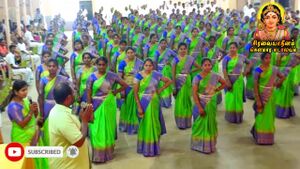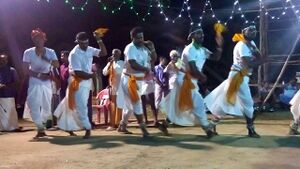Oyil Kummi: Difference between revisions
Cyril.alex (talk | contribs) No edit summary |
Cyril.alex (talk | contribs) No edit summary |
||
| Line 1: | Line 1: | ||
{{Read Tamil|Name of target page=ஒயில் கும்மி|Title of target page=ஒயில் கும்மி}} | {{Read Tamil|Name of target page=ஒயில் கும்மி|Title of target page=ஒயில் கும்மி}} | ||
[[File:Oyil kummi.jpg|thumb]] | [[File:Oyil kummi.jpg|thumb]] | ||
Oyil Kummi is a type of [[Kummi]] (a type of group dance) dance with limited movements. In this art, it is customary to orate the story through singing similar to [[Oyil Attam]]. This art is performed for the [[Mulaippari]] festival in places of worship. This art is closely related to Oyil Attam art. The art is also known as the | Oyil Kummi is a type of [[Kummi]] (a type of group dance) dance with limited movements. In this art, it is customary to orate the story through singing similar to [[Oyil Attam]]. This art is performed for the [[Mulaippari]] festival in places of worship. This art is closely related to Oyil Attam art. The art is also known as the '''Nattu Kottu Aattam''<nowiki/>' (Country drums dance) | ||
== Performance Method == | == Performance Method == | ||
[[File:Oyil kummi1.jpg|thumb]] | [[File:Oyil kummi1.jpg|thumb]] | ||
Oyil Kummi is performed in order to bring prosperity in the agriculture, lessen the blights and bring the rains. The theme of the Oyil Kummi songs include accomplishing perfect dance, state salutations, healing of diseases, description of the car festival, execution of rituals, praising Mulaippari as Kannathal (folk deity), business events, prospering wealth with crops growth, note on relationship and reference to the village. | Oyil Kummi is performed in order to bring prosperity in the agriculture, lessen the blights and bring the rains. The theme of the Oyil Kummi songs include accomplishing perfect dance, state salutations, healing of diseases, description of the car festival, execution of rituals, praising Mulaippari as Kannathal (folk deity), business events, prospering wealth with crops growth, note on relationship and reference to the village. | ||
In this art, there is a practice of selecting only part of the | In this art, there is a practice of selecting only part of the [[Harichandra Purana|Harichandra]] story which portrays the episode of Lokidasan death due to snake bite, and singing it in their own way. | ||
They dance with [[Salangai]] (a musical anklet) tied to their ankles in Oyil Kummi also, similar to Oyil Attam. Oyil Kummi also involves hammering the palms with a cloth in the hand. There is no training for the Oyil Kummi performed ritually. None of performers wear makeup when they dance. | They dance with [[Salangai]] (a musical anklet) tied to their ankles in Oyil Kummi also, similar to Oyil Attam. Oyil Kummi also involves hammering the palms with a cloth in the hand. There is no training for the Oyil Kummi performed ritually. None of performers wear makeup when they dance. | ||
Towards the end the dancers may sit down in a circular formation and dance, they may also form a straight line and dance. | |||
In villages near to | In villages near to places where Oyil Attam is popular, Oyil Kummi dancers wear trousers and banyans, and dance with balloons tied around their ribbon headbands. This practice can be attributed to the influence of Oyil Attam. Nowadays, performers wear cloth anklets with metal bells. | ||
== Musical Instruments == | == Musical Instruments == | ||
In this event, they use anyone of the musical instruments such as Paanaithalam (percussion instrument | In this event, they use anyone of the musical instruments such as ''Paanaithalam'' (Pot percussion instrument), ''Thorpaanaithalaam'' (Pot with mouth covered in leather) and ''Singhi'' (Cymbal). | ||
== Performing Locations == | == Performing Locations == | ||
Both Oyil Attam and Oyil Kummi take place at a specified common area in the village or at an adjacent area, which is sprinkled with cow dung water. This area will be | Both Oyil Attam and Oyil Kummi take place at a specified common area in the village or at an adjacent area, which is usually sprinkled with cow dung water and dried. This area will be stage for this art. | ||
== Performing Community == | == Performing Community == | ||
In this art, people belonging to the intermediate castes like Idaiyar and Kallar participate. This art is mostly performed by men. In some places, women | In this art, people belonging to the intermediate castes like Idaiyar and Kallar participate. This art is mostly performed by men. In some places, women perform this dance by themselves. | ||
== Reference == | == Reference == | ||
* Thamilaga Nattar Nigalthu Kalaigal - [[A.K. Perumal]] | * Thamilaga Nattar Nigalthu Kalaigal - [[A.K. Perumal]] | ||
| Line 25: | Line 25: | ||
* [https://www.youtube.com/watch?v=LE8M7nzsVmU Veeramuthu Oyil Kummi] | * [https://www.youtube.com/watch?v=LE8M7nzsVmU Veeramuthu Oyil Kummi] | ||
[[Category:English Content]] | [[Category:English Content]] | ||
{{ | {{Finalised-en}} | ||
Revision as of 19:44, 13 October 2022
இந்தப் பக்கத்தை தமிழில் வாசிக்க: ஒயில் கும்மி
Oyil Kummi is a type of Kummi (a type of group dance) dance with limited movements. In this art, it is customary to orate the story through singing similar to Oyil Attam. This art is performed for the Mulaippari festival in places of worship. This art is closely related to Oyil Attam art. The art is also known as the 'Nattu Kottu Aattam' (Country drums dance)
Performance Method
Oyil Kummi is performed in order to bring prosperity in the agriculture, lessen the blights and bring the rains. The theme of the Oyil Kummi songs include accomplishing perfect dance, state salutations, healing of diseases, description of the car festival, execution of rituals, praising Mulaippari as Kannathal (folk deity), business events, prospering wealth with crops growth, note on relationship and reference to the village.
In this art, there is a practice of selecting only part of the Harichandra story which portrays the episode of Lokidasan death due to snake bite, and singing it in their own way.
They dance with Salangai (a musical anklet) tied to their ankles in Oyil Kummi also, similar to Oyil Attam. Oyil Kummi also involves hammering the palms with a cloth in the hand. There is no training for the Oyil Kummi performed ritually. None of performers wear makeup when they dance.
Towards the end the dancers may sit down in a circular formation and dance, they may also form a straight line and dance.
In villages near to places where Oyil Attam is popular, Oyil Kummi dancers wear trousers and banyans, and dance with balloons tied around their ribbon headbands. This practice can be attributed to the influence of Oyil Attam. Nowadays, performers wear cloth anklets with metal bells.
Musical Instruments
In this event, they use anyone of the musical instruments such as Paanaithalam (Pot percussion instrument), Thorpaanaithalaam (Pot with mouth covered in leather) and Singhi (Cymbal).
Performing Locations
Both Oyil Attam and Oyil Kummi take place at a specified common area in the village or at an adjacent area, which is usually sprinkled with cow dung water and dried. This area will be stage for this art.
Performing Community
In this art, people belonging to the intermediate castes like Idaiyar and Kallar participate. This art is mostly performed by men. In some places, women perform this dance by themselves.
Reference
- Thamilaga Nattar Nigalthu Kalaigal - A.K. Perumal
Video Links
✅Finalised Page


